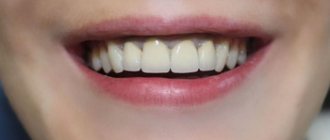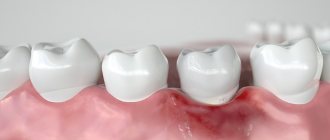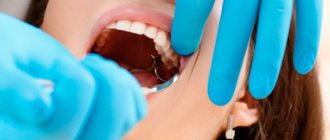Darkening of the tooth near the gum can be caused by various reasons. Not all of them are associated with dental diseases and pathological processes in the oral cavity. For example, sometimes a tooth darkens due to taking medications containing iron gluconate, or excessive consumption of grape or tomato juice.
However, in most cases, the causes of darkening of the tooth near the root and gums are pathological processes. This is a reason to immediately contact a dentist. The following diseases lead to this symptom:
- Cervical caries;
- Tartar;
- Fluorosis.
Let's talk about these diseases and methods of treating them in more detail.
Cervical caries
Cervical caries is localized on the neck of the tooth - the place where the enamel comes into contact with the gum. This pathological process occurs very quickly, which makes it one of the most dangerous types of this disease. Cervical caries can develop into pulpitis, periodontitis or a root pathological process within just a few months. It is much faster than localized, for example, on the vestibular or occulus surface.
Cervical caries requires immediate treatment. If the disease is started, the pathological process will quickly “spread” to the roots of the tooth. In this case, the patient will begin to experience acute pain. When the roots are destroyed, it becomes impossible to save the tooth, and the only way to “treat” is removal.
But there are also advantages. If cervical caries is detected at an early stage, when the pathological process has not yet affected the dentin and roots of the tooth, this disease can be cured using a conservative method. The dentist will perform fluoridation and remineralization of the enamel, restoring its strength. In this case, preparation is not required or minimal.
If the pathological process has reached the dentin - the patient is concerned not only about the darkening of the tooth, and increased sensitivity, as well as pain - then treatment is carried out by filling. The dentist removes the destroyed tissue, then cleans the tooth from the remains of harmful microorganisms and closes it with a filling.
The most common cause of cervical caries is insufficient dental hygiene. To prevent this disease, it is necessary to brush your teeth regularly, at least 2 times a day, use floss (dental floss), and, if you are predisposed, use an irrigator.
Professional dental care
Treatment of blackening of teeth near the gums in the dental office includes several stages:
- Elimination of the reasons that provoked the color change.
- Bleaching.
If the surface of the tooth near the gum has turned black due to the presence of cervical caries, measures must be taken to eliminate it. Treatment options for blackening will depend on the stage of enamel damage:
- At the black spot stage, remineralizing therapy is used: the tooth surface is cleaned of plaque and stone, and applications with fluoride-containing compounds are applied to the affected area.
- At the stage of superficial caries, the affected area is polished and eliminated.
- In case of average caries, the damaged part of the tooth is removed, the area is treated with a special preparation and a filling is installed.
- In case of deep caries, the pulp is removed and the canals are cleaned, after which a filling is installed.
If the tooth turns black at the gum due to tartar deposits, the affected areas are cleaned using one of the selected methods:
- mechanical – manual method using special tools;
- chemical - removal of solid deposits using compounds based on alkalis and acids;
- ultrasonic cleaning – devices that emit sound waves are used to clean enamel;
- laser – removal of tartar with a laser.
The teeth whitening procedure is the final stage of cleansing the enamel from darkened plaque. For this purpose use:
- laser installations;
- ultrasound;
- chemical compositions;
- special lamps.
Tartar
Tartar is a bacterial-mineral plaque that forms on the cervical surface of the enamel due to insufficient oral hygiene, as well as due to smoking and an incorrect diet.
First, a soft coating forms on the surface. It consists of bacteria and food debris. Soft plaque is easy to clean - it is removed even when chewing carrots, apples and other hard foods, as well as during oral hygiene using a toothbrush, floss or irrigator.
However, if a person does not remove the soft plaque, it can begin to petrify - change its structure, become hard and mineral. Turn into tartar. Hard plaque is much more difficult to remove - it often even resists cleaning with a classic brush.
Tartar is not only unsightly, it is also the cause of many diseases. For example, it can cause gingivitis and other gum inflammations. This occurs due to contact between bacteria and soft tissues of the oral cavity. But the most dangerous consequence of tartar is periodontitis, the inflammatory process of the periodontium, the tissues surrounding the roots and base of the tooth. It can lead to tooth mobility and loss.
Tartar treatment is quick and comfortable. Ultrasound, laser, or Air Flow technology can be used to break down mineral deposits. The dentist chooses a specific technique depending on the characteristics of the disease. Thus, thin dental plaque is cleaned using the Air Flow method - mineral deposits are removed by a water-air flow with the addition of active substances.
Gum necrosis
Causes of necrosis
Types of gum necrosis and treatment
Symptoms of the disease
Diagnosis of the disease
Prevention of the development of gum necrosis
Gum necrosis (from the Greek nekros - dead) is the death of tissue that occurs due to cessation of blood circulation. This disease is difficult to detect at an early stage, as its symptoms are barely noticeable. Another danger is that this process is irreversible. Therefore, if the doctor has diagnosed gum necrosis, it is important to take appropriate measures as soon as possible to prevent the development of pathology. In this article we will look at the causes of necrosis, its types, and also tell you how to avoid it.
Fluorosis
Fluorosis is a dangerous dental disease that is caused by consuming extremely large doses of fluoride. Usually this substance enters the human body along with tap water. In addition, the source of fluoride can be the work environment or even the wrong toothpaste.
Fluorosis begins with the appearance of white, dull spots on the surface of the teeth. They are not always visible to the naked eye. Over time, the spots change color - they first turn yellow, then turn brown. If you don’t consult a dentist at this point, fluorosis can turn into erosive or destructive forms - when the disease begins to destroy the enamel.
Treatment of fluorosis is almost always conservative. The dentist remineralizes the enamel, restoring the balance of calcium, phosphorus and fluoride. Darkened areas are bleached. In addition, the patient is recommended to change his lifestyle to reduce the amount of fluoride consumed - for example, install a special water filter at home or change his place of work.
Fluorosis is often “epidemic” in nature. If it is caused by an increased content of fluoride in tap water, it develops in the whole family. If the reason was a violation of industrial safety - for the entire team. In the Ryazan region, fluorosis is often detected in residents of the Rybnovsky, Chuchkovsky and Shatsky districts, where the water contains an increased amount of fluoride.
Other diseases that can cause darkening of gums
The appearance of dark spots disrupts the aesthetics of a smile and may indicate serious disorders in the body. Problems with the gums lead to bad breath and pain. This is dangerous due to sleep disturbances, decreased performance, and ignoring communication.
Darkening may be caused by:
- general diseases of the body;
- smoking;
- injury;
- hit by a foreign object;
- complications during treatment and tooth extraction;
- improper installation of dental crowns.
Dental treatment
Before implantation, sanitation of the oral cavity is indicated, which consists of identifying and treating pathological changes. Darkening may occur after dental treatment. When filling teeth, amalgam can be used - an alloy of mercury with one or more metals. This filling material is used for chewing teeth in patients of any age, regardless of the severity of caries.
The disadvantage of amalgam is a reaction to contact of the material with the oral mucosa. It is expressed in the appearance of dark spots on the gums. Spots may appear immediately after treatment or after some time. Such manifestations are not considered a pathology. To improve aesthetics, stains are removed surgically.
General diseases of the body
Darkening may be due to the presence of common diseases. Peutz-Jeghers syndrome is characterized by the presence of dark spots on the skin and mucous membranes. This hereditary disease is diagnosed in early childhood. It occurs as a result of a gene mutation and is accompanied by the growth of hamartomatous polyps in the gastrointestinal tract. Therefore, another name for the disease is hamartomatous polyposis.
Darkening and the formation of dark spots on them do not appear immediately. These symptoms develop with age. External signs of the disease are not dangerous. However, their cause poses a serious threat to the health and life of the patient. Polyps provoke the development of cancer of internal organs. No effective comprehensive treatment for the syndrome has been developed.
Regular examination allows you to monitor the development of the disease. If polyps reach critical sizes, they are removed. Medicines that prevent the appearance of tumors are also prescribed.
Changes in gum color may be a symptom of Addison's disease . This is an endocrine disease with disruption of the adrenal glands, which are unable to produce hormones in the required quantities.
If the disease is present, the dark spots have an irregular shape and may form stripes. Their presence is due to changes in the balance of hormones, provoking melanin deposits. Associated signs of the disease are loss of appetite, general malaise, fatigue, and bronze skin tone.
Black gums and teeth due to smoking
The color change may be due to smoking, because nicotine causes changes in the body that are very difficult to reverse. Smoker's melanosis is characterized by discoloration of the oral mucosa, discoloration of teeth, and an unpleasant odor.
Any diseases of the mucous membrane caused by smoking, under unfavorable conditions, can subsequently become malignant. Therefore, in order to get rid of pigmentation, you should get rid of the main cause, i.e. stop smoking. Afterwards, the spots are removed using laser correction.
Treatment of a darkened tooth
Darkening of the tooth near the gum requires immediate consultation with a doctor, regardless of the cause. If you leave the disease to its own devices, you can face more dangerous and serious consequences.
The doctors at our regional dental clinic are ready to help. We use modern equipment, progressive therapeutic practices and always put the patient's comfort as a priority. Therefore, treatment of a darkened tooth will be quick and effective. Don’t let the disease lead to dangerous consequences - make an appointment with the dentist!
Tips for teeth whitening and plaque removal at home - pros and cons
Dental whitening is carried out using peroxides with a high concentration of active whitening components. A home whitening system includes a special tray, a gel with a low concentration of hydrogen peroxide. The procedure is carried out without ultraviolet irradiation, so it is longer than a session in clinics. The zoom system is absolutely painless, it allows you to lighten darkened enamel up to 4 tones, the lasting result lasts for a year. The latest modification of the zoom 3 system is distinguished by its gentle effect and simple technology.
Advantages of this method:
- allows you to whiten yellow teeth and blackened enamel;
- removes old deep brown spots caused by smoking, age-related changes, and the use of antibiotics;
- improves the dark color of teeth due to genetic predisposition when other methods are powerless;
- safety;
- harmlessness;
- possibility of lightening by several shades;
- speed, efficiency of achieving results;
- prolonged action.










